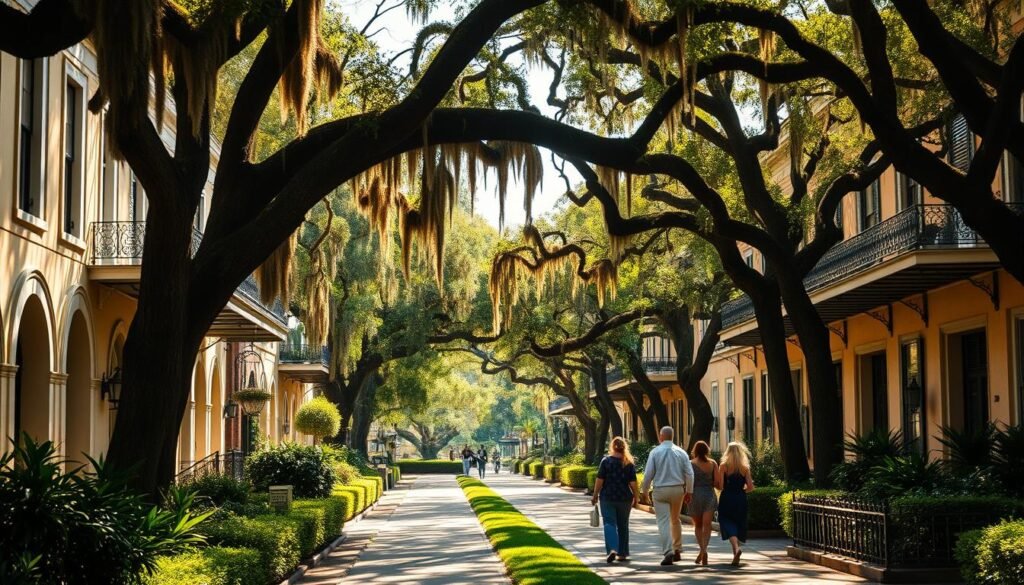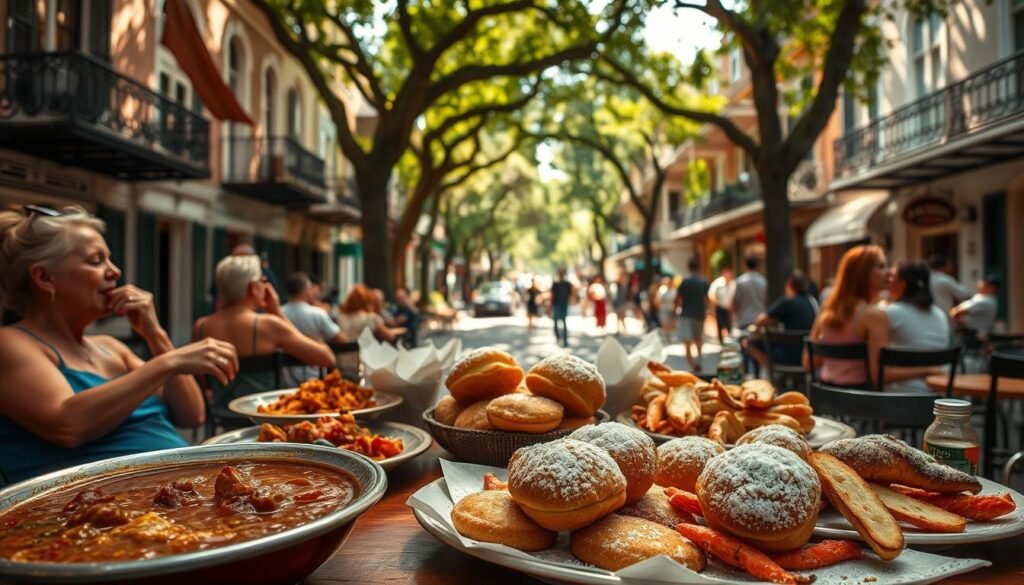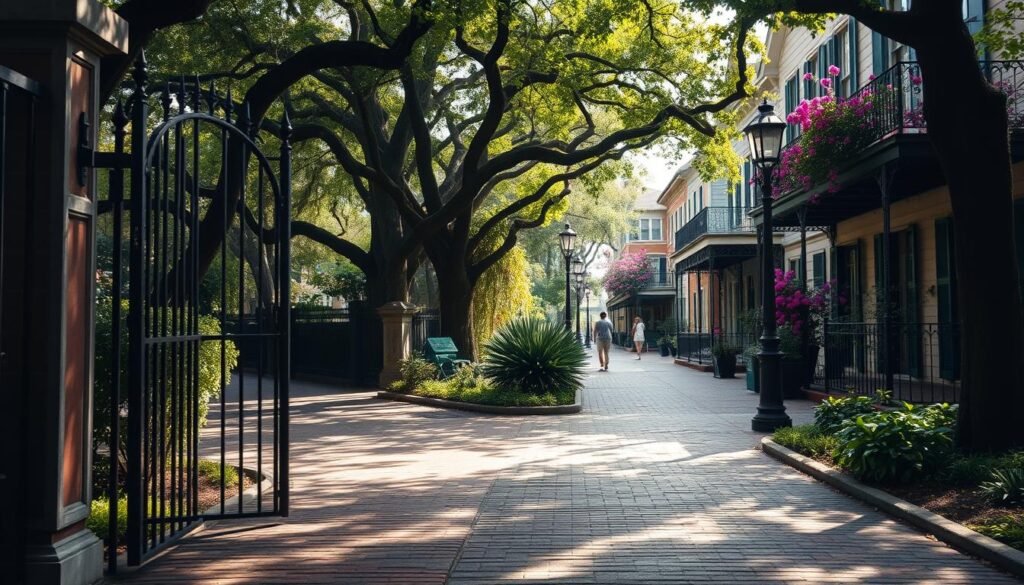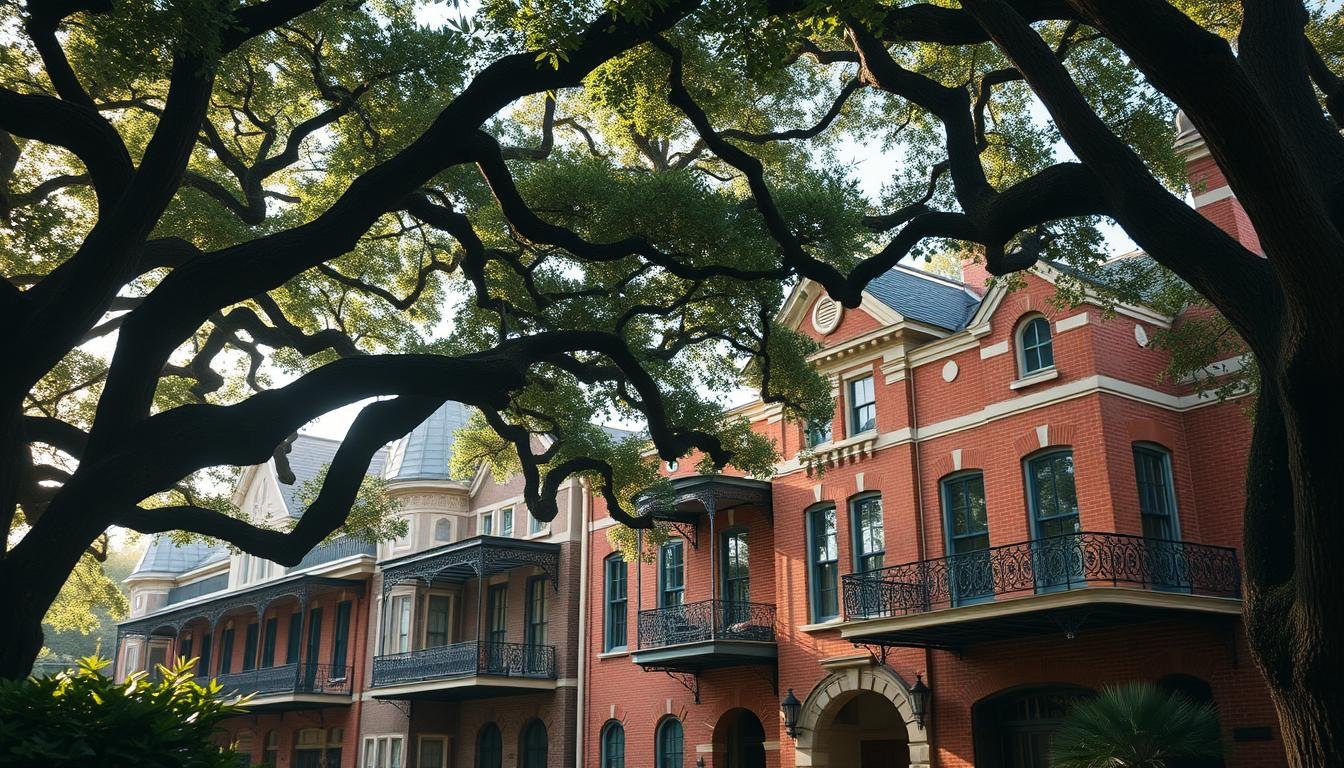As a local, I’m excited to share with you the charm of this stunning neighborhood on foot. The Historic Garden District is filled with historic homes and lush gardens that showcase the city’s rich cultural heritage.
Taking a stroll through the Garden District allows you to experience the architectural charm and must-see sites up close. With its unique blend of Victorian and Greek Revival styles, this neighborhood is a true gem.
Key Takeaways
- Explore the Historic Garden District’s stunning architecture on foot
- Discover the charming historic homes and their beautifully maintained gardens
- Experience the rich cultural heritage of the area
- Visit must-see sites and take in the local atmosphere
- Enjoy the unique blend of Victorian and Greek Revival styles
Introduction to the Garden District
As you step into the Garden District, you’re immediately enveloped in the charm of one of New Orleans’ most historic neighborhoods. This enchanting area is a treasure trove of architectural delights, rich history, and cultural significance, making it a must-visit destination for anyone drawn to the mystique of New Orleans.
The Garden District is a unique blend of Southern hospitality and urban sophistication, offering visitors an experience that’s both relaxing and invigorating. Whether you’re on a guided tour or prefer self-guided exploration, the area’s architectural charm is sure to captivate.
What Makes the Garden District Unique?
The Garden District stands out for its stunning antebellum mansions, picturesque parks, and intricate ironwork. The neighborhood is a masterclass in Greek Revival, Italianate, and Victorian architectural styles, showcasing the creativity and craftsmanship of 19th-century builders.
- Intricate ironwork adorns balconies and galleries, adding a touch of elegance to the homes.
- The area is renowned for its picturesque parks and gardens, offering serene escapes from the bustling city.
- The blend of architectural styles reflects the cultural melting pot that is New Orleans.
As noted by architectural historian, “The Garden District is a testament to the city’s ability to preserve its history while embracing its cultural heritage.”
A Brief History of the Area
The Garden District’s history dates back to the 19th century when it was developed as a suburban retreat for the wealthy. The area’s proximity to the Mississippi River and its picturesque landscape made it an attractive location for grand estates.
Over the years, the Garden District has evolved, influenced by the city’s cultural and economic shifts. Today, it’s a vibrant neighborhood that celebrates its history while embracing modernity.
As you explore the Garden District, you’ll uncover stories of the past, from the antebellum era to the present day. The area’s history is palpable, woven into the fabric of its architecture, gardens, and community.
Planning Your Walking Tour
As you prepare for your walking tour of the Garden District, let’s dive into the essentials to make your experience unforgettable. With its picturesque streets and historic homes, this neighborhood is a treasure trove of New Orleans’ rich history and culture.
Best Times to Visit
The best time to visit the Garden District is during the spring or fall when the weather is mild and pleasant. Avoid visiting during the peak summer months when the heat and humidity can be overwhelming. If you’re looking for a more serene experience, consider visiting early in the morning or late in the afternoon when the streets are less crowded.
Essential Items to Bring
To ensure a comfortable and enjoyable walking tour, be sure to bring comfortable shoes, sun protection, and plenty of water. You may also want to consider bringing a camera to capture the beautiful architecture and historic landmarks.

Recommended Tour Routes
There are several recommended tour routes to explore the Garden District. One popular route is to start at the intersection of Magazine Street and Jackson Avenue, then make your way down to Lafayette Cemetery No. 1. Another option is to explore the historic homes along Coliseum Street, which offer a glimpse into the neighborhood’s rich architectural heritage.
As a local guide, I recommend taking the time to wander down the side streets and explore the hidden gems that make the Garden District so unique. Whether you’re interested in history, architecture, or simply soaking up the atmosphere, there’s something for everyone in this charming neighborhood.
Iconic Architecture of the Garden District
New Orleans’ Garden District is renowned for its breathtaking architecture, a blend of Greek Revival, Italianate, and Victorian styles that reflect the city’s rich cultural heritage. As you walk through the neighborhood, the stunning antebellum mansions and charming cottages transport you to a bygone era, showcasing the area’s historic homes and architectural charm.
Notable Styles and Features
The Garden District is characterized by its diverse architectural styles, each with its own unique features. You’ll notice the intricate ironwork, ornate galleries, and vibrant colors that give the homes their distinctive charm. The Greek Revival style, with its imposing columns and pediments, is particularly prevalent, while the Italianate style adds a touch of elegance with its ornate brackets and cornices.
| Architectural Style | Notable Features |
|---|---|
| Greek Revival | Imposing columns, pediments |
| Italianate | Ornate brackets, cornices |
| Victorian | Intricate woodwork, patterned masonry |
Famous Homes and Landmarks
No visit to the Garden District would be complete without seeing some of its most famous homes and landmarks. The must-see sites include the stunning Robbrell House, the picturesque Colonel Short’s Villa, and the historic Lafayette Cemetery No. 1. These iconic sites are a testament to the area’s rich history and architectural heritage, making the Garden District a truly unique and fascinating destination.
Historic Highlights Along the Way
As we stroll through the charming Garden District, we’re surrounded by a rich history that unfolds at every turn. This neighborhood is a living, breathing testament to New Orleans’ unique cultural heritage.
Let’s start with some of the most significant historic sites you’ll encounter on our walking tour. First up is the renowned Lafayette Cemetery No. 1, a hauntingly beautiful above-ground cemetery that’s been the final resting place for many of New Orleans’ most prominent citizens.
The Lafayette Cemetery No. 1
This cemetery is not just a place of reverence; it’s an outdoor museum showcasing the city’s history and architectural ingenuity. As your local guide, I’ll share stories about the families buried here and the significance of the elaborate tombstones.

The Columns Hotel
Just a short walk from the cemetery, we’ll come across The Columns Hotel, a stunning example of Victorian-era architecture. This hotel has been a Garden District landmark since 1883, offering a glimpse into the lives of the city’s elite during the late 19th century.
The Southern Food and Beverage Museum
Another must-see site on our tour is the Southern Food and Beverage Museum. This museum is dedicated to preserving the culinary history of New Orleans and the South. Here, you’ll discover the rich culinary traditions that have shaped the city’s cuisine.
To give you a better understanding of these historic highlights, here’s a brief comparison of what you can expect at each location:
| Location | Historical Significance | Notable Features |
|---|---|---|
| Lafayette Cemetery No. 1 | Above-ground cemetery with historic tombs | Elaborate tombstones, historic families buried here |
| The Columns Hotel | Victorian-era hotel since 1883 | Stunning architecture, historic landmark |
| Southern Food and Beverage Museum | Culinary history of New Orleans and the South | Exhibits on food history, culinary artifacts |
As we continue our New Orleans Garden District walking tour, you’ll gain a deeper appreciation for the city’s history, architecture, and culture. Each of these sites offers a unique window into the past, making our tour a truly immersive experience.
Local Eateries to Explore
As you wander through the Garden District’s lush gardens on a guided tour or self-guided exploration, the temptation to indulge in local flavors is irresistible. The neighborhood is dotted with eateries that serve up classic New Orleans cuisine, from casual cafes to upscale restaurants.
Must-Try Restaurants in the Area
Some restaurants stand out for their unique offerings and historic significance. Here are a few must-try spots:
- Commander’s Palace: A Garden District institution since 1893, known for its upscale Creole cuisine and exceptional service.
- Dooky Chase’s Restaurant: While not directly in the Garden District, this legendary spot is just a short drive away and serves up iconic dishes like gumbo z’herbes.
- Gautreau’s: A contemporary take on Creole cuisine in an elegant setting.
New Orleans Cuisine Highlights
New Orleans is renowned for its culinary heritage, with dishes that blend French, Spanish, African, and Caribbean influences. Be sure to try some of these local favorites:
- Beignets: Fried dough pastries covered in powdered sugar, typically enjoyed with coffee or chicory.
- Po’ Boys: Sandwiches made with crispy French bread and filled with a variety of ingredients, from fried oysters to roast beef.
- Jambalaya: A hearty rice dish cooked with sausage, chicken, and a mix of spices.

Cafés for a Quick Break
For a quick respite from your walking tour, the Garden District offers several charming cafes where you can relax and recharge. Some top picks include:
- Cafe Degas: A cozy spot serving coffee, pastries, and light bites.
- The Columns Hotel’s Victorian Lounge: Enjoy a Sazerac or other classic cocktails in an elegant setting.
Whether you’re in the mood for a leisurely meal or a quick snack, the Garden District’s eateries have something to satisfy every craving.
Tips for Enjoying Your Walking Tour
As you lace up your walking shoes and prepare to explore the charming Garden District, here are some insider tips to make your tour truly unforgettable. The Garden District is a treasure trove of history, architecture, and culture, and with a little guidance, you can experience it to the fullest.
Navigating the Streets Safely
While the Garden District is generally a safe area, it’s always wise to be mindful of your surroundings, especially in a new city. Stick to the main paths and well-lit streets, and consider exploring with a group or partner. Be sure to watch out for uneven sidewalks and historic homes with steps or other obstacles.
Additionally, New Orleans can be quite warm and humid, so don’t forget to stay hydrated and take breaks in shaded areas or local cafes. This will help you keep your energy up and enjoy the tour without feeling overwhelmed.
Engaging with Local History and Culture
The Garden District is steeped in history and culture, from its stunning antebellum mansions to the poignant Lafayette Cemetery No. 1. To truly appreciate the area, take the time to read the historic markers and plaques scattered throughout the neighborhood. These provide valuable insights into the lives of the people who once called this place home.
Moreover, don’t be shy about striking up conversations with locals – whether it’s a shopkeeper, a café owner, or a fellow tourist, sharing stories and experiences can enrich your understanding and appreciation of the Garden District. Consider visiting during one of the many local events or festivals to get a deeper feel for the community.

By following these tips, you’ll be well on your way to having a memorable and enjoyable walking tour of the Garden District. Whether you’re drawn to the area’s historic significance, architectural beauty, or cultural vibrancy, this tour is sure to leave a lasting impression.
Capturing the Perfect Photos
With its unique blend of architectural styles and beautiful gardens, the Garden District offers endless opportunities for capturing the perfect shot. As we explore this charming neighborhood, you’ll discover that every corner turned is a potential photograph waiting to happen.
Scenic Spots for Photography
The Garden District is replete with must-see sites that are a photographer’s dream. From the stunning architectural charm of its historic homes to the vibrant colors and textures of its lush gardens, every scene is a potential masterpiece.
Some of the top scenic spots include the picturesque streets lined with oak trees, the intricate ironwork of the balconies, and the beautifully maintained gardens that seem to spill out onto the sidewalks. Don’t forget to capture the unique perspectives offered by the Lafayette Cemetery No. 1, with its above-ground tombs and statues.
Tips for Taking Great Shots
To make the most of your photography experience in the Garden District, consider a few tips from a local’s perspective. First, take your time – the best shots often come from slowing down and observing the light and shadows.
- Pay attention to the golden hour, just before sunset, when the light casts a warm glow over the neighborhood.
- Experiment with different angles and perspectives to add depth to your photos.
- Don’t be afraid to get up close and capture the intricate details of the architecture and gardens.
By following these tips and keeping an eye out for the architectural charm and natural beauty, you’ll be sure to capture the essence of the Garden District in your photographs.
Understanding the Local Culture
As I stroll through the Garden District, I’m constantly reminded of the rich cultural heritage that permeates every corner of this historic neighborhood. The area’s unique blend of traditions, architecture, and artistic expressions makes it a fascinating place to explore.
The Garden District’s cultural identity is deeply intertwined with the broader New Orleans culture, which is known for its vibrant celebrations and rich history. One of the most significant influences on the local culture is Mardi Gras, a carnival celebration that brings the city to life with parades, music, and elaborate costumes.
The Influence of Mardi Gras
Mardi Gras is more than just a party; it’s a reflection of the city’s history and cultural diversity. The celebration has its roots in medieval Europe, but New Orleans has made it its own, incorporating traditions from France, Spain, Africa, and beyond. As you walk through the Garden District, you can see the influence of Mardi Gras in the elaborate decorations and vibrant colors that adorn many of the historic homes.
Some of the ways Mardi Gras influences the local culture include:
- The use of bright colors and ornate decorations in home decor
- The prevalence of jazz and other music genres associated with Mardi Gras celebrations
- The incorporation of Mardi Gras traditions into everyday life, such as King Cake parties
Role of Music and Arts
Music and arts are integral to the cultural fabric of the Garden District. New Orleans is renowned for its jazz heritage, and you can still hear the sounds of jazz drifting through the streets, especially during live performances at local venues. The area is also home to numerous art galleries and studios, showcasing the work of local artists who draw inspiration from the city’s unique cultural landscape.
The role of music and arts in the Garden District is multifaceted:
- It preserves the city’s cultural heritage through traditional music and art forms
- It fosters creativity and innovation among local artists
- It enhances the overall aesthetic appeal of the neighborhood, making it a more enjoyable place to visit and live
By understanding the local culture, you’ll gain a deeper appreciation for the Garden District and its significance within the broader context of New Orleans. As your local guide, I’m excited to share my insights into the cultural heritage that makes this neighborhood so unique and captivating.
Conclusion: The Magic of the Garden District
As we wrap up our walking tour of the Garden District, take a moment to soak in the charm of this enchanting neighborhood. Whether you’ve joined a guided tour or embarked on a self-guided exploration, I hope you’ve fallen in love with the area’s historic homes, picturesque gardens, and rich cultural heritage.
Recalling the Journey
Reflecting on your tour itinerary, you might recall the stunning architecture, the tranquil atmosphere of Lafayette Cemetery No. 1, or the vibrant energy of the local eateries. Each step revealed a new story, a new character, and a new layer of this complex, fascinating neighborhood.
Planning Your Next Visit
As you plan your next visit, consider exploring different aspects of the Garden District. You might take a deeper dive into its history, visit during a different season, or simply wander the streets, discovering new hidden gems. The magic of the Garden District awaits your return, ready to be re-explored and re-appreciated.

Leave a Reply